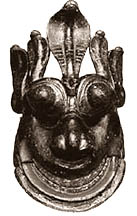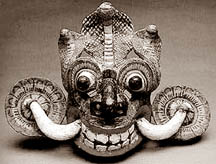|
observer |
|
|
|
|
|
OTHER LINKS |

|

|

|
Psycho-drama cures via the yakka mask
A midnight ceremony. Crowds milling, bodies slick with sweat in the tropical night. Torches lining an earthen arena. A patient is dazed with illness, propped on a low seat. The rhythmic beat of drums. The smell of smoking resin. A figure enters, back first and the rhythm of the drums changes, intensifies. The figure whirls and the patient is suddenly presented with the face of his tormentor! The yakun natima, or devil dance ritual, is nothing if not full of drama. Not just a charade or interval designed to entertain, the yakun natima is a carefully crafted ritual with a history reaching far back into Sri Lanka's pre-Buddhist past. It combines ancient Ayurvedic concepts of disease causation with deft psychological manipulation. Lasting up to twelve hours, it mixes raucous humour with deep-rooted fears to create a healing catharsis for both patient and community. But while the beating of the drums, the torchlight, and the smoky resin contribute to the aura of the night's magic, it is the masked face of the edura, or exorcist/shaman, that personifies the power of the moment-the devil incarnate. It is the mask or vesmuna which localises the fears and anxieties of both patient and audience. To the Sinhalese, it is this face, carved of wood, with bulging eyes, protruding nose and gaping mouth, disfigured and fierce, which represents both cause and cure. Spiritual talismansFor the ethnographer, the traditional belief systems and practices surrounding the yakun natima and other masked dance rituals of Sri Lanka's southern coast provide a rich and fascinating field for research. For the collector, these ritual masks represent a sophisticated folk art form; beautiful and mysterious. Carved of wood and pigmented with natural hues and resins, these masks are infused with a spirit and animation which command attention.
The pagination of a ritual mask, darkened by years of use, and the repairs upon repairs of cherished examples bespeak their importance within their village communities. Within the context of the dance they are hypnotising. Taken out of that context and viewed on their own they are masterpieces of a rich folk art tradition. The medical systems of the Sinhalese have been renowned since the first century B.C. when the northern capital in Anuradhapura boasted some eighteen hospitals. Traditional Ayurvedic principles practised for centuries-balancing internal humours to promote and modify health-are now being studied and implemented by many Western healthcare professionals. But predating these systems, and stretching far back into antiquity, there has been an alternative system of healing, a system based on early Vedic concepts of aetiology, in which diseases and ills of all sorts were believed to be caused by demons. Identified predominantly by the symptoms manifested by the patient, these demons could be summoned and exorcised in stylised ritual mask dances, or natima. PersonificationsThrough a complex and sophisticated mixture of theatre and drama, which includes wearing special clothes, burning his own body and simulated death experiences, the edura creates a space where in his mind and in the mind of his fellow villagers he "becomes" something other and takes on the essence of and personifies the afflicting demon. Most important to this transformation both visually and psychologically are the fantastic masks worn during these rituals. Representing specific demons and the maladies they inflict upon man, the masks allow the edura to embody, at least temporarily, demons which normally exist only on a supernatural plane. This personification allows for dialogue and, amidst frenzied dance and ritualised chants and speeches, provides an opportunity to discuss the troubles facing the individual and the community. The edura, cloaked in the power and visage of the demon, creates a visible and immediate link between the natural and the supernatural. As the embodiment of the afflicting demon he cites causes for disease, discusses immediate concerns for the community, and following the reception of a tribute, he promises to lift the illness.
The cosmology of traditional Sri Lankan beliefs is a complex mixture of native Vedic gods, spirits, and demons, overlaid with imported Hindu and Buddhist deities, beliefs, and practices. This pantheon is vast, filled with hierarchies and sub-hierarchies which the uninitiated finds nearly impossible to grasp. The synthesis is a spiritual landscape where Buddha reigns supreme, but where the day-to-day is fraught with danger from the yakku (devils) and other malignant forces (vas) which seem all too ready to afflict man with scourges of every description. In this word, life is a constant struggle against these forces. Central to this struggle are the natima devil dances-masked dance ceremonies to cure diseases, help failing crops, prevent drought, and provide protection for troubled pregnancies. A cast of specific characters and dramas have developed over the centuries to counteract almost every affliction and ailment. The yakun natima, and the kolam natima (masquerade dance) represent two of the historically prominent forms these dance rituals have taken. Masks used in these rituals provide wonderful insight into the belief systems and practices which form the core of traditional Sinhalese beliefs regarding health. Edura's aidOf all the dance rituals, the yakun natima focuses most directly on healing. In Sinhalese thought diseases are either caused by the natural or the supernatural. In the case of the natural, traditional Ayurvedic and/ or medical avenues are pursued. In the case of the supernatural, or where the other systems fail, they have traditionally turned to the edura for aid through such rituals as the yakun natima. Form and colourAlthough the identities of some demons are difficult to ascertain out of context, many masks can be readily identified by form and colour. Biri-sanniya, the demon for deafness, for example, is consistently depicted with a cobra emerging from one eye and covering the side of the face where the ear would be. This relates directly to the Sinhalese belief that the cobra has no ears and therefore must "hear" with its eyes. Kora sanniya, the demon for lameness/paralysis, is often depicted with the features of one side of the face drawn up, approximating the signs of a stroke. Amuku sanniya, the demon for stomach disorders and vomiting, is often depicted with a green face, wide open eyes, and a partially protruding tongue. The kolam natima belongs to a different category of ritualised mask dance than the yakun natima. Today it is rarely practised and has been gradually losing its importance over the last hundred years. The early twentieth century writer Otaker Pertold commented that, even in his day, much of the original import of the dance had been lost, and that on the few occasions that it was still performed it was undertaken by laymen rather than edura or those specifically versed in ritual dances. Because some forty masked characters are involved in this elaborate drama, with commensurate offerings expected for certain devils and demons, Pertold cites the great expense involved in staging a full kolam natima as responsible for its gradual abbreviation. As a ritual, the kolam natima broadly centres around pregnancy issues. The cravings and desires (dola duka) that often accompany a pregnancy were traditionally viewed with great suspicion, and were believed to be some sort of supernatural possession. The masked dance is thought to have been principally directed against these cravings and to protect the fetus in general. Virgin of the snakesThus the impact of the kolam natima lies not in its great narrative strength but in the pure spectacle of the masks: the Lasquarine soldier who lost his nose in the great battle of Gampelle; the great Virgin of the Snakes with her radiant face surrounded by coiled cobras; the golden faced and seductive woman with five bodies; the greedy moneylender, Hettiya; the haggard old man and old woman dressed in rags looking for support from the young villagers etc. The masks of the yakun natima and other dance rituals of Sri Lanka represent a re-pository of a fast-fading culture. Sharing their heritage with a broad range of shaman- based mask cultures of Asia, these masks speak a language which is increasingly falling on deaf ears. As the role of the edura becomes increasingly marginalised in Sinhalese society, and education begins to transform traditional concepts of the interaction between the natural and the super-natural, the yakku and the various devils are gradually fading from popular con-sciousness. And while mask carving for tourists and dance performances for the outsider will persist, the fundamental spirit, potency, and vitality of both natima rituals and their masks will sadly be lost. *** List of demons Paul Wirz, in his seminal work Exorcism and the Art of Healing in Ceylon (1954), lists the following demons and their effects: Kana-sanniya (blindness), Kora-sanniya (lameness/paralysis), Gini-jala-sanniya (malaria),Vedda-sanniya (bubonic plague), Demala-sanniya (bad dreams), Kapala-sanniya (insanity), Golu-sanniya (dumbness/muteness), Biri-sanniya (deafness). Maru-sanniya (delirium). Amuku sanniya (vomiting), Gulma-sanniya (parasitic worms), Deva-sanniya (epidemic disease, i.e. typhoid, cholera), Naga-sanniya (evil dreams particularly with snakes), Murta-sanniya (swooning, loss of consciousness), Kala-sanniya (black death), Pita-sanniya (disease related to bile), Vata-sanniya (shaking and burning of limbs), and Slesma-sanniya (secretions, epilepsy). |











